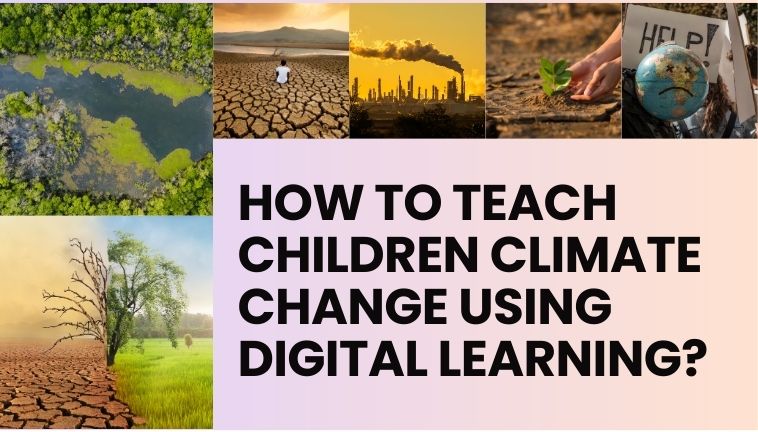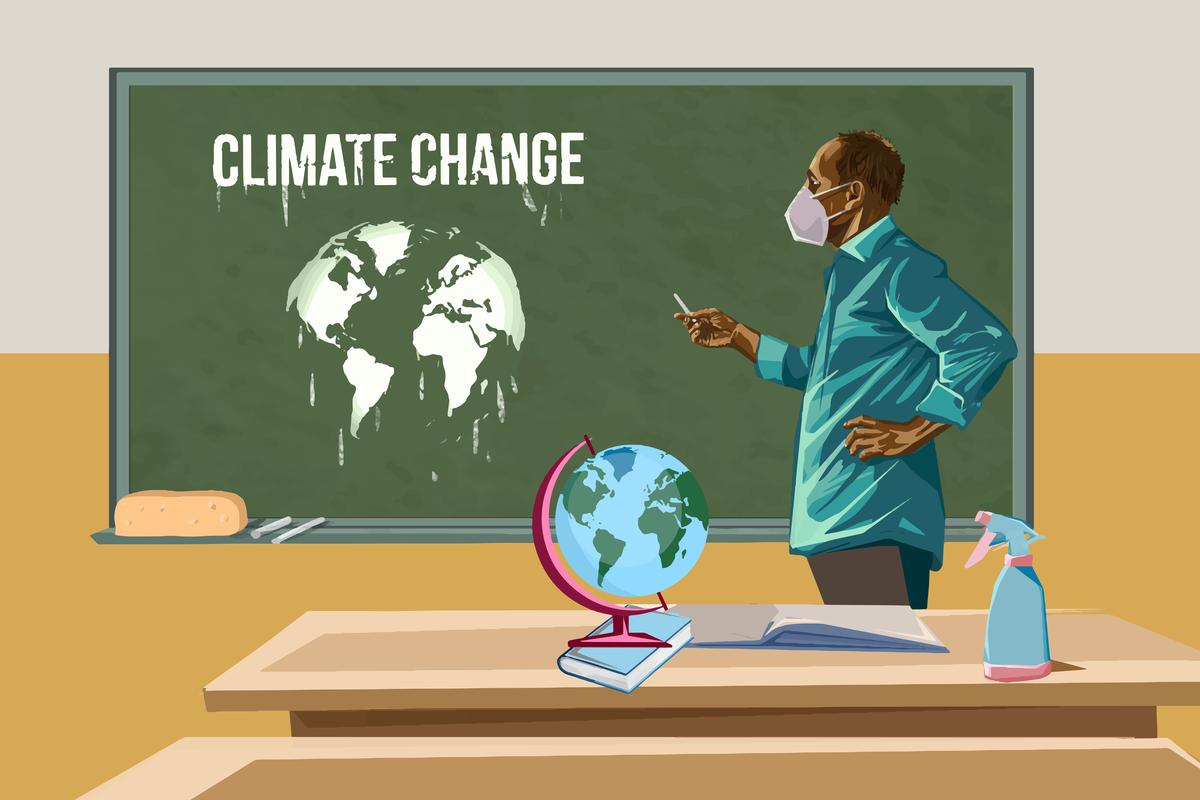Blogs
How to Teach Children Climate Change Using Digital Learning?

Climate change stands as the biggest challenge for humanity, casting a shadow on both our present and future. The weight of this predicament is not lost on the younger generation. With digital learning, we can educate them effectively about climate change.
In a recent survey by the Royal College of Psychiatrists, a staggering 57% of child and adolescent psychiatrists disclosed their engagement with children distressed over the climate crisis. The rise of eco-anxiety among young minds mirrors a deep concern for the well-being of our planet.
As educators, we bear the responsibility of integrating this concern into our curriculum. It's not merely about a one-off discussion on global warming; it should be a fundamental aspect of our teaching approach. Utilizing digital learning, we can effectively educate students about climate change and empower them to take action
Our learners must grasp the intricacies of what causes climate change, understand its repercussions, and explore the concerted efforts needed to combat it.
The challenge then becomes: How do we educate about climate change with accuracy while remaining empathetic and supportive to the anxieties of our students?
1. Use digital learning to know more about climate change
Navigating the terminology associated with climate change is essential for creating awareness. Take a deep dive into these crucial concepts with the help of digital learning to increase curiosity of young minds regarding climate change :

- Defining Climate:
Climate refers to the prolonged weather patterns in a specific location. Simplify this concept with insights and offer a straightforward explanation of weather and climate using examples.
- Unveiling the Greenhouse Effect:
Explore the process where gasses trap the Sun's heat in Earth's atmosphere. Human activities, like burning fossil fuels, intensify this effect, contributing to the warming of our planet.
- Decoding Climate Change:
Understand the profound impact of climate change—a sustained increase in temperatures and shifts in weather patterns.
- Global Warming Insight:
Delve into the process of global warming, unraveling the factors leading to the planet's gradual heating.
- Understanding Sea Level Rise:
Rising temperatures trigger the melting of glaciers and ice sheets, elevating sea levels. Learn how warming water expands, contributing to the rapid rise—a crucial metric for gauging the speed of our planet's transformation.
- Exploring Habitat Loss and Species Extinction:
Study the concept of habitat loss—when an environment can no longer sustain its flora and fauna. Recognize its role as a primary threat to 85% of species on the IUCN's red list, highlighting the intersection of human behavior, habitat loss, and climate change.
2. Show students the connection between rising temperature and human activity using digital learning resources
A wealth of evidence supports the reality of climate change, as illustrated by graphs depicting the upward trajectory of global temperatures. Yet, this narrative is only half the tale. By leveraging digital learning and immersing learners in satellite images, we can showcase the transformations our world has undergone.

Lockdown provided a stark illustration of the direct link between human activity and climate change. A temporary dip in our bustling pace revealed a glimpse of the planet's resilience. The International Energy Agency reported a nearly 50% drop in global road activity compared to 2019, leading to a fleeting improvement in air quality.
While this momentary environmental respite has dwindled, it serves as a significant reminder that positive human action can spark hope. The lesson is clear: when humanity chooses to act, the planet responds.
3. Start a dialogue
Create a space for your learners to open up about climate change. Provide them with opportunities to express their concerns, and most importantly, validate their feelings – because they are genuine.
Incorporate regular discussions about climate change into your curriculum, making it an integral part rather than a one-time topic. The primary curriculum naturally aligns with environmental themes, offering abundant chances for meaningful conversations.
Engaging in discussions allows learners to cultivate critical thinking, enabling them to analyze problems from various perspectives. It also nurtures creative thinking, empowering them to devise innovative solutions to environmental challenges.
For instance, when exploring materials, seamlessly connect it to recycling. Foster critical thinking by prompting learners to ponder over the fate of items they discard. Encourage discussions on whether an item has reached its ultimate end or if someone else could still use it.
Initiate conversations about recycling and the potential for reusing materials. Set up science labs to spark insights. Challenge them to contemplate the barriers that hinder people from recycling. Then, spark their creative minds by asking how they could play a role in educating and supporting others to effectively sort and store their waste for recycling.
By weaving climate discussions into everyday lessons, you not only enrich your curriculum but also empower learners to think critically and creatively about their role in environmental stewardship.
4. Be proactive in addressing climate change concerns through digital learning initiatives.
Empower your learners to think about positive ways they can contribute to tackling climate change. It's crucial to emphasize that responsibility lies with everyone; our young people should not carry this burden alone.
Taking positive action not only instills a sense of control but also nurtures hope. Even small changes can have a significant impact.
Engaging in environmental projects and establishing environmental science labs provides a practical framework for action. These initiatives not only benefit the environment but also offer a structured approach for learners to make a meaningful impact.
5. Connect with nature
Encouraging learners to understand and enhance their local environment contributes to their broader understanding of the world. By participating in these initiatives, learners not only make positive changes but also gain valuable insights into the interconnectedness of our global ecosystem.
Consistent research highlights the positive impact of a strong connection to nature on our wellbeing. Our relationship with the natural world significantly influences our emotional, psychological, and physical health.
Prioritize enough opportunities for your learners to immerse themselves in quality time outdoors.
- Encourage them to deeply engage with nature by:
- Sitting quietly, utilizing all their senses to actively absorb the surrounding world.
- Initiating conversations about how being in nature affects their emotions and thoughts.
- Prompting them to share thoughts on something they find beautiful in the natural environment.
- Inspiring creativity by encouraging artistic expressions like art, poetry, dance, or music in response to nature.
Taking positive actions to create a space for nature within your school grounds.
By fostering this profound connection to nature, you not only contribute to the holistic development of learners but also enhance their overall well-being.
6. Include Sustainable Development Goals in your curriculum
The Sustainable Development Goals (SDGs) represent an ambitious initiative aimed at creating a better world. Integrating these goals into the curriculum adds a global dimension to our learners' educational experience.
While some teachers may perceive the curriculum as overstuffed, a closer look reveals that the SDGs complement existing concepts and ideas. Incorporating the SDGs into your curriculum facilitates a nuanced understanding of the links between various subjects and key ideas.
By weaving the SDGs into learning experiences, learners gain insights into how these ideas transcend subject boundaries, applying them to real-world contexts. This not only enhances their understanding but also fosters a sense of responsibility towards creating a more sustainable and interconnected world.
In Conclusion
In confronting the monumental challenge of climate change, our role as educators is pivotal in shaping a generation that is not just academically adept but environmentally conscious. The evidence is clear—our students grapple with eco-anxiety, and the curriculum must respond empathetically and proactively.
Digital learning serves as a powerful ally, unraveling complex climate concepts and showcasing the tangible impact of human activity through satellite images. And Schoolnet serves as your constant companion to elevate the teaching and learning outcomes of educators and learners alike with its digital learning solutions.
Ready to learn limitlessly about climate change with Schoolnet?





